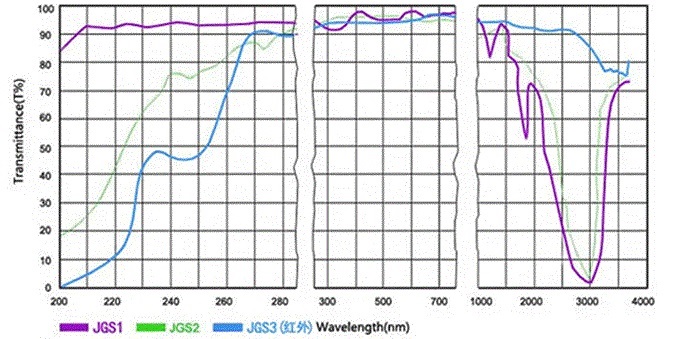Introduction to the Spectral Transmittance of Quartz Plates
Introduction to the Spectral Transmittance of Quartz Plates
Quartz plates exhibit unique optical properties, allowing them to transmit far ultraviolet light, making them the premier choice among materials for UV transmission. They are also capable of transmitting visible light and near-infrared light. Due to their high-temperature resistance, minimal thermal expansion coefficient, excellent chemical stability, and comparable characteristics in terms of bubbles, stripes, uniformity, and birefringence to standard optical glass, quartz glass is an indispensable optical material known for its high stability even in harsh environments.
Factors Affecting Spectral Transmittance
The spectral transmittance of quartz plates is influenced by three main factors: reflection, scattering, and absorption. The reflection of quartz glass is typically around 8%, with slightly higher values in the ultraviolet region and lower values in the infrared region. As a result, the overall transmittance of quartz glass is generally no more than 92%. Scattering in quartz glass is minimal and can usually be ignored. Spectral absorption is closely related to the impurity content and manufacturing processes of quartz glass.
Transmittance below 200 nm: Indicates the presence of metallic impurities.
Absorption at 240 nm: Reflects the extent of oxygen deficiency.
Visible range absorption: Caused by the presence of transition metal ions.
Absorption peak at 2730 nm: Corresponds to hydroxyl groups and can be used to calculate hydroxyl content.
Types of Quartz Plates
Far Ultraviolet Optical Quartz Plates(JGS1):
Transparent in the ultraviolet and visible spectral ranges.
No absorption bands in the 185-250 nm wavelength range.
Strong absorption bands in the 2600-2800 nm range.
Non-luminescent and stable against light radiation.
Ultraviolet Optical Quartz Plates(JGS2):
Transparent in the ultraviolet and visible spectral ranges.
No absorption bands in the 200-250 nm wavelength range.
Strong absorption bands in the 2600-2800 nm range.
Non-luminescent and stable against light radiation.
Infrared Optical Quartz Plates (JGS3):
Transparent in the visible and infrared spectral ranges.
No significant absorption bands in the 2600-2800 nm range.

Applications of Quartz Plates
Quartz plates are widely utilized in various fields due to their exceptional optical properties:
Scientific Research: Quartz plates are used in spectrophotometers and other analytical instruments for measuring light absorption and transmission across different wavelengths, particularly in UV-Vis spectroscopy.
Semiconductor Manufacturing: In the production of semiconductors, quartz plates serve as substrates and optical components, allowing precise control of light during photolithography processes.
Laser Technology: Quartz glass is employed in laser systems due to its ability to transmit high-energy light without significant absorption, making it ideal for applications in medical and industrial lasers.
Optical Devices: Used in the fabrication of lenses, windows, and prisms for microscopes, telescopes, and other optical instruments, quartz plates ensure high clarity and minimal distortion.
Environmental Monitoring: Quartz plates are used in equipment for monitoring air and water quality by analyzing the absorption of pollutants in the UV range.
Telecommunications: In fiber optics, quartz glass is critical for transmitting signals over long distances with minimal loss, making it essential for modern communication networks.
Conclusion
The exceptional optical properties and high stability of quartz glass make it an essential material in various applications, from scientific research to industrial uses. Its ability to transmit a wide range of wavelengths, coupled with its resistance to harsh conditions, positions quartz glass as a leading choice for advanced optical technologies.

